
Latest news reports and images from Mars
Edition 7...April 2007 Published by www.Rockhoundstation1.com Hellas City; Mars
FIRST WOMAN ON MARS!
Today I4 March 2007 a Third human being was successfully transported to Mars via the Moltech corporation's new experimental quantum transfer system. The new system "QELT" (Quantum extra luminal transfer) was used to transport Sally Taylor member of "Global Matrixx network systems" to the red planet...
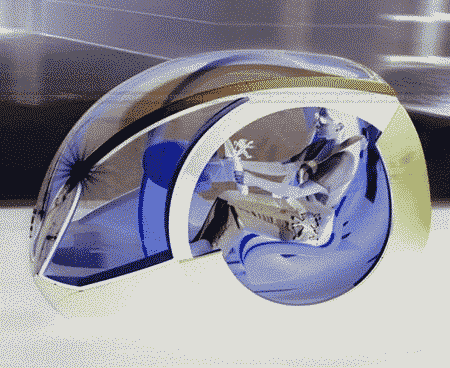
Sally Taylor. Reporter for the Rockhound Station 1 Gazette materialising
at the Moltech reception facility in Hellas city Mars.
Hello Earth Indiana here ...How are you doing? Seeing as how I been stuck on this planet since the middle of 2005...Soon as John (Dr John Wayfarer Second man on Mars) arrived (you can read all about his arrival by clicking link 6 at the bottom of this page.) I thought, "great the gizmo is working' so I left John to look after Mars then went back in his pod...I've been on earth for a few months holiday...What a weird experience, felt like I was carrying a sack full of rocks on my back...Change of gravity, and the noise everywhere you go, noise. -O). I came at the same time as Sally Taylor, the first woman on Mars
You can read all about her arrival in the HNS wire transmission below.
News
Sally Taylor became the first woman on Mars today. Mz Taylor arrived at the Moltech reception facility in Hellas city on Mars. Looking rather nervous and slightly disorientated by the journey to the red planet Mz Taylor said " I can't belive I'm really here, I keep bumping into things I am still useing the same energy to move about as I did on earth, with one third of earths gravity here on Mars, if I walk quickly I can't stop in time so crunch I bump into things, or rather I bounce off them". Mz Taylor was accompanied by Robert Velare (Indiana) on the journey to Mars. They were meet on arrival by Dr John Wayfarer...Who greeted them saying "My its starting to get pretty crowed on this planet" and laughing.
Dr Wayfarer has been working in Hellas for the past month preparing the Aquarius expedition.

Sally Taylor in transit Hellas station Mars.
In the background robots waiting to board the Mars express.
Star of Mars on display in Hellas City: Mars
Special Feature Page from the Mars Chronicle.
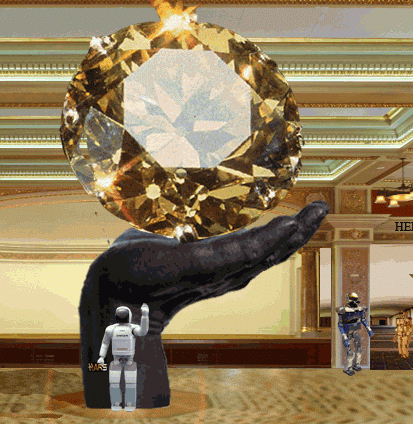

On display in Hellas City the "Star of Mars": Click image to enlarge.
The largest diamond ever discovered, was found in the south of the Planitia Acidalia region of Mars on Thursday 17th of August 2006 at 10. 19 am GMT. The yellow orange diamond is estimated to weight nearly 5 tons in its uncut form. It was discovered in the Planitia Acidalia region of Mars by a reconnaissance expedition lead by Robert Velare, journalist for The Mars Chronicle.
The stone was extracted from the terrain by robots. The diamond christened "The Star of Mars"weighed 2.5 million carat in its uncut form...After faceting and polishing it now weights 2.2 million carat At current prices of $1000 a carat (over five carat) its worth...2.2 Billion Dollars.The enormous gem is now cut and polished and is on display at the Lowell centre in Hellas City Mars.
RHS1 HELLAS NEWS SERVICE: MARS.

PLANUM AUSTRALE;
CLIMATE CHANGE: MARS!"

"Expedition investigating climate change on Mars" ;
Dr John Wayfarer, Sally Taylor, Indiana...South pole Mars: Click the image to enlarge.
Dr John Wayfarer, Sally Taylor, Indiana...South pole Mars: Click the image to enlarge.
30 March 2007.
RHS1 Hellas Crater News service. Hellas city, Mars.
April 05, 2007
PROJECT RA...
The changing climate on Mars
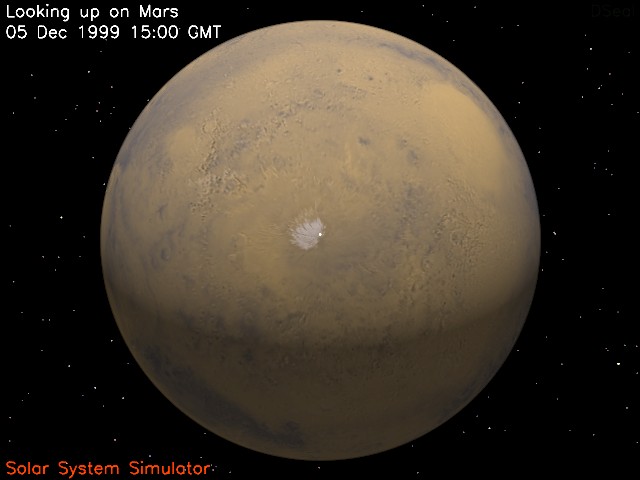
South Pole Mars.
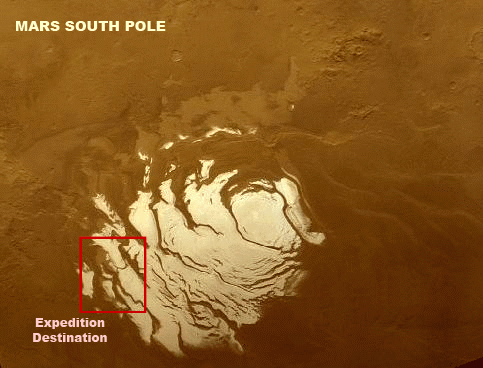
South Pole Mars.Image Credit: NASA/JPL/Malin Space Science Systems.
This is the south polar cap of Mars as it appeared to the Mars Global Surveyor (MGS) Mars Orbiter Camera (MOC) on April 17, 2000. In winter and early spring, this entire scene would be covered by frost. In summer, the cap shrinks to its minimum size, as shown here. Even though it is summer, observations made by the Viking orbiters in the 1970s showed that the south polar cap remains cold enough that the polar frost (seen here as white) consists of carbon dioxide. Carbon dioxide freezes at temperatures around -125 degrees C (-193 degrees F). Mid-summer afternoon sunlight illuminates this scene from the upper left from about 11.2 degrees above the horizon. Soon the cap will experience sunsets; by June 2000, this pole will be in autumn, and the area covered by frost will begin to grow. Winter will return to the south polar region in December 2000. The polar cap from left to right is about 420 km (260 mi) across.
Image Credit: NASA/JPL/Malin Space Science Systems
Mars possesses polar caps at both poles, which mainly consist of water ice. Frozen carbon dioxide (dry ice) accumulates as a thin layer about one metre thick on the north cap in the northern winter only, while the south cap has a permanent dry ice cover about eight metres thick. The northern polar cap has a diameter of approximately 1,000 kilometers during the northern Mars summer, and contains about 1.6 million cubic kilometres of ice, which if spread evenly on the cap would be 2 kilometres thick. The southern polar cap has a diameter of 350 km, and a thickness of 3km. Both polar caps show spiral cuts, which remain unexplained. Both polar caps shrink and regrow following the temperature fluctuation of the Martian seasons.
Mars: Carbon dioxide = 95.32% of the atmosphere:

Dr John Wayfarer: Expedition leader south pole Mars
The Mars Chronicle in conjunction with RHS1 Earthwatch News and the Moltech corporation, Mars, have launched an expedition "Project Ra" to report on the climate changes taking place here on Mars. The focus of the expedition is Mars south pole the permanent ice cap.The expedition left from Hellas city on the 27th of march 2007 with 200 robots and droids. Travelling due south overland. A base camp will be setup before venturing onto the ice shield.
The Purpose of the mission is to check Solar radiation and set up temperature station metodroids.
A spokesman for the Moltech corporation said "After the data from the Mars Express was processed we were surprised at the quantity of ice contained at mars south pole. If, as has been postulated, the Sun is changing its parameters, this is of serious concern to us as the Hellas basin is the lowest point on mars. With the amount of ice indicated by the data any melting would turn the Hellas basin into the Hellas sea. It is for this main reason the expedition has been organised.The depth of the Hellas crater is 7 km, or 3.7 to 4.3 miles, below the topographic datum, or "sea level" of Mars. So we need to be concerned".
What is concerning Moltech is the satellite image below , showing what appears to be water surrounding the ice at Mars south pole.This area in the photograph is the destination of the expedition.
"The long-term increase in solar irradiance is heating both Earth and Mars,"
Habibullo Abdussamatov, head of space research at St. Petersburg's Pulkovo Astronomical Observatory in Russia.
The orbital theory of climate change has been successful in explaining changes in the Earth's climate,
and we have used cores of the Greenland and Antarctic ice caps to reconstruct past climates
and atmospheres on Earth, this means that we can now use the Mars caps in a similar way".
Jack Mustard, associate professor of geological sciences at Brown University.
"It is completely of no consequence why the martian poles may be melting.
Solar radiation or orbital mechanics are irrelevant to Moltech.
The only relevant
facts at this time are "is the south pole melting?"and to what degree?.
Professor Michael Ptarmigan, Director Research & Development Moltech Corporation, Mars.
"The Rising Tide"
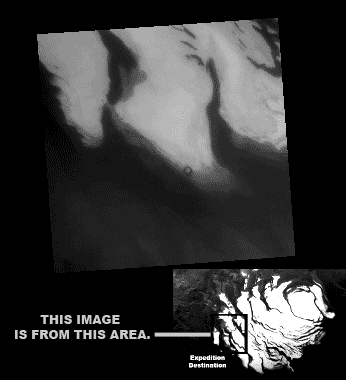
MOC red wide-angle context image R13-01098...NASA/JPL/Malin Space Science Systems.
Click here to learn more about this image
15 March 2007
The amount of water trapped in frozen layers over Mars' south polar region is equivalent to a liquid layer about 11 metres deep covering the planet.
This new estimate comes from mapping the thickness of the dusty ice by the Mars Express radar instrument that has made more than 300 virtual slices through layered deposits covering the pole. The radar sees through icy layers to the lower boundary, which in places is as deep as 3.7 kilometres below the surface.
European Space Agency.

27 March 2007: Travelling due south overland: Mars.
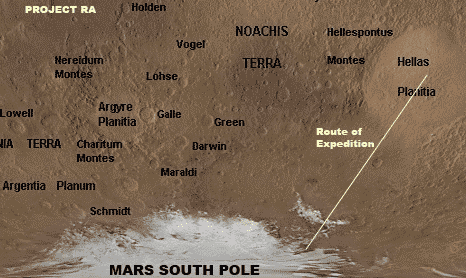

Sally Taylor: Expedition member south pole Mars
Sally Taylor will be reporting the journey in RHS1 Gazette

Indiana & Optica: Expedition members south pole Mars
"The Pits of Planum Australi".
1991-2001
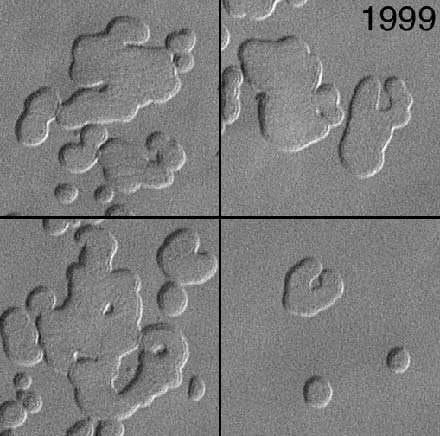
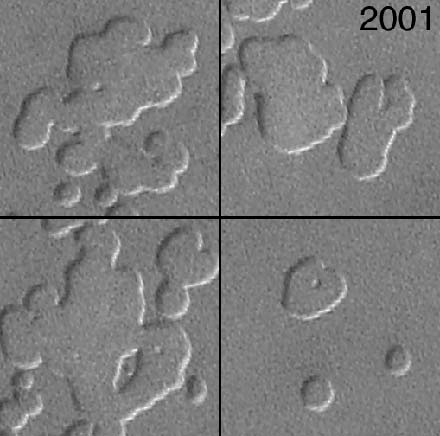
Images Credit: NASA/JPL/Malin Space Science Systems
MOC images of the south polar cap taken in 1999 were compared with images of the same locations taken in 2001, and it was discovered that pits had enlarged, mesas had shrunk, and small buttes had vanished. In all, the scarps that enclose the pits and bound the mesas and buttes retreated about 3 meters (3.3 yards) in 1 martian year (687 Earth days). This rapid retreat of polar scarps can only occur if the ice is frozen carbon dioxide (also known as "dry ice"). Retreat of scarps made of water ice is much slower and would not have been measurable from one martian year to the next.
The portion of the martian south polar cap that persists through summer is called the residual polar cap. The two sets of four pictures shown here are from four places on the residual south polar cap. The pictures from 1999 were taken in October of that year, the corresponding pictures from 2001 were acquired in August, approximately 1 Mars year after the 1999 images were obtained. In each case, the pictures are illuminated by sunlight from the upper left, and each shows an area about 250 meters (273 yards) across. The polar cap is layered, and the layers have eroded to form pits, troughs, mesas, and buttes. The pits form as sunlight warms frozen carbon dioxide during southern spring and summer, and the ice sublimes away. There is so much carbon dioxide that it does not all go away in one summer---in fact, it may take hundreds to thousands of years to disappear.
These new observations indicate that the south polar residual cap is not permanent. It is disappearing, a little bit more each southern spring and summer season. At the present rate, a layer 3 m thick can be completely eroded away in a few tens of martian years. Since each layer is equivalent to about 1% of the mass of the present atmosphere (which is 95% carbon dioxide), if sufficient carbon dioxide is buried in the south polar cap, the mass of the atmosphere could double in a few hundred to a thousand Mars years. That could lead to profound changes in the environment. For example, it would change how much and where wind erosion would occur, and where and for how long liquid water could survive at or near the surface.
It also means that Mars may have been very different in the recent past (perhaps only a few thousands of years ago). On today's Mars, the ice is eroding, but in the past that material had to have been deposited. The martian climate was probably colder, and there was more carbon dioxide in the atmosphere. For some reason, large amounts of carbon dioxide froze at the south pole---one might say that there was a "Martian Ice Age"---and this freezing occurred on a time scale similar to that of the most recent Ice Age on Earth.
Mars is changing, and it is changing on a time scale that we can measure and observe. If all of the carbon dioxide that is being released into the atmosphere from the south polar cap is not freezing out somewhere else, and if it is not being adsorbed into the martian soil, then it must be causing the atmospheric pressure to increase. If this is so, and if one were to assume that the entire known volume of the polar cap is made of carbon dioxide that sublimes (turns into a gas) at the same rate we see today, then it could increase the martian atmospheric pressure by as much as 10 times, to about 1/10th the density of Earth's atmosphere, in just the next few thousand years. Although this atmosphere would not be breathable, carbon dioxide is a "greenhouse gas" that would cause the global temperature to increase considerably and make it easier for liquid water to persist elsewhere on the planet. Perhaps, just perhaps, a thickening martian atmosphere would eventually make it easier for people to live on Mars.
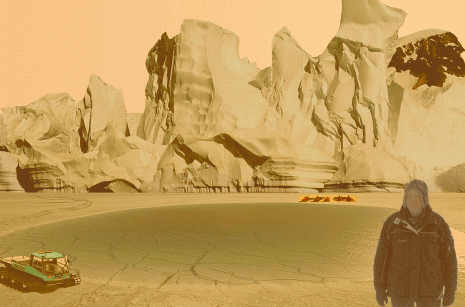
WATER...In a CO2 pit (Ancient impact crater) at the south pole of Mars: Click the image to enlarge.
August 7, 2003:
As the cap shrinks it develops rifts, dark spots, and a ragged border. Lately, for instance, amateur astronomers using 8-inch and larger telescopes have been watching a frosty mountain range emerge from the ice. Says Smith, "these are the Mountains of Mitchel"--named after the Ohio astronomer who first spotted them 150 years ago. A bold dark rift called Rimas Australis cuts through the polar ice just south of those mountains.
Here's an amazing fact: The seasonal polar caps are made of martian air that freezes during winter. Depending on the time of year, more than a quarter of the martian atmosphere can be found lying on the ground around the poles. (The atmosphere is 95% CO2; that's why the seasonal polar caps are made of dry ice.) (source:NASA.)
August , 2005:
"To see new gullies and other changes in Mars surface features
on a time span of a few years presents us with a more active, dynamic
planet than many suspected before Mars Global Surveyor got there,"
Michael Meyer, Mars Exploration Program chief scientist, NASA Headquarters, Washington.
An Historic Moment.

5 April 2007: Dr John Wayfarer, Sally Taylor, Indiana, at the geographical south pole of Mars
"The south polar layered deposits of Mars cover an area as wide as a big portion of Europe. The amount of water they contain has been estimated before, but never with the level of confidence this radar makes possible," said Dr Jeffrey Plaut of NASA's Jet Propulsion Laboratory, Pasadena (California), co-Principal Investigator for the radar and lead author of the study.
The polar layered deposits extend beyond and beneath a polar cap of bright-white frozen carbon dioxide and water at Mars' south pole. Dust darkens many of the layers. However, the strength of the echo that the radar receives from the rocky surface underneath the layered deposits suggests the composition of the layered deposits is at least 90 percent frozen water. One area with an especially bright reflection from the base of the deposits puzzles researchers. It resembles what a thin layer of liquid water might look like to the radar instrument, but the conditions are so cold that the presence of melted water is deemed highly unlikely....
European Space Agency.
"Thar she blows"!
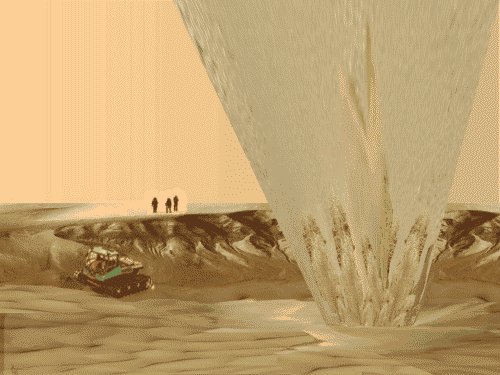
A small CO2 geyser at the south pole of Mars: Click the image to enlarge.
The south polar cap, which like on Earth is composed of water ice mixed with layers of dust and sand. In the southern the pole is in shadow for several months. During this time the temperature drops to -130degrees C, cold enough for carbon dioxide to freeze out of the atmosphere and form a thin coating over the ice. More dust and ice covers this material in a slab about a metre thick
When spring begins and the sunlight falls on the pole again, the carbon dioxide begins to turn to gas (a process called sublimation). Eventually pressure builds up and the gas bursts through weak spots in the overlying slab, jetting out at about 150 km an hour. Images from THEMIS show dark spots and fans and spider-shaped markings where the jet erodes the surrounding terrain.
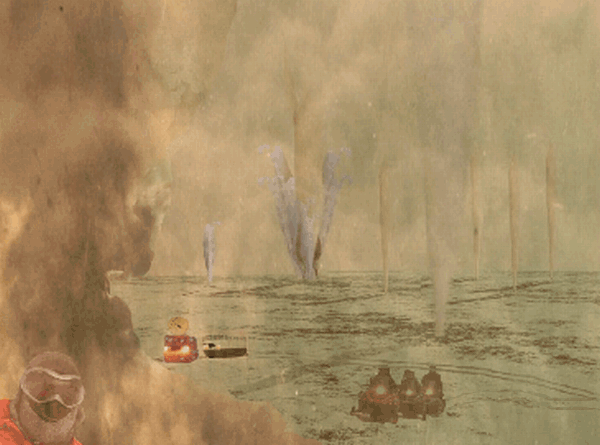
Crossing a carbon dioxide Geyser zone south pole of Mars
The gas geysers last for several months until the overlying slab sublimates away completely. Phil Christensen from Arizona State University believes a nearby explorer would see a dramatic and exotic sight. If you were there you'd be standing on a slab of carbon-dioxide ice. All around you, roaring jets of CO2 gas are throwing sand and gas a couple of hundred feet into the air This is unlike anything that occurs on Earth.
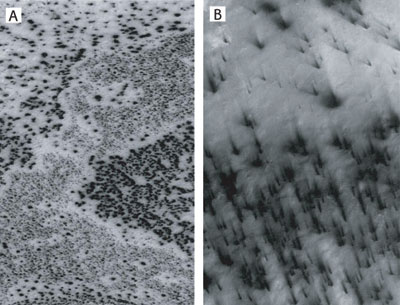
Dark spots (left) and fans (right) mark the sites of carbon dioxide geysers in this Mars Global Surveyor picture. Image: NASA/JPL/Malin Space Science Systems
"On the Beach, Mars"
Mare Australi
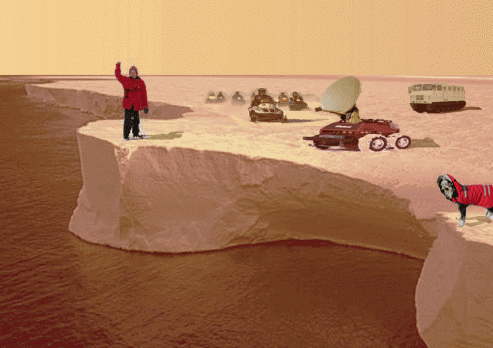
Hello NASA; Hello ESA, how are you doing?
H20 professor!...
At the south pole of Mars;
All the best...Indy
"One area with an especially bright reflection from the base of the deposits puzzles researchers.
It resembles what a thin layer of liquid water might look like to the radar instrument, but the conditions
are so cold that the presence of melted water is deemed highly unlikely."
Dec 2001.
"Mars may help us decipher how natural climate systems, on Mars and Earth, respond to rapid perturbations.
The observations, if they do in fact lead to climate changes on Mars, also suggest that natural climate change
may completely dominate human-induced climate change.
Some people have suggested terraforming Mars (altering its environment to make it more habitable,) but our
observations suggest that Mars is already experiencing a larger change than humans may ever be able to induce."
Michael Malin, of Malin Space Science Systems
READ THE EXPEDTION REPORT AND FINDINGS
DISCOVER ABOUT CLIMATE CHANGE ON MARS
IN THE NEXT EDITION OF

Latest news reports and images from Mars
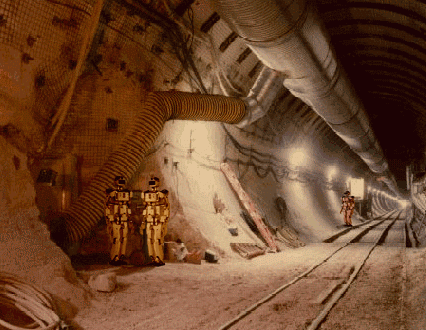
Lake Xanadu to Hellas water tunnel; progress so far
All the best...Indiana : April 2007 Mars
Your roving reporter for the Mars Chronicle
Optica

To boldly go were no dog has ever gone before!.
Journey to the Centre of Mars!
Aquarius Expedition...Mars.

Sponsors of the Aquarius Expedition: Destination the interior of the planet Mars ...
click the image to enlarge

In next Months Edition...Exclusive
Interview: Professor Michael Ptarmigan
Moltech Corporation Research and Development.
By Sally Taylor. RHS1 Gazette.
Before I arrived on Mars; I took the opportunity to Interview one of the most elusive and reticent members of the Moltech Corporation.
Discover how Indiana and Optica were marooned on Mars...Revealed first details of the QELT system...And much more..

satellite image map of Mars .
..Click here

satellite image map of Mars . ..Click here

Purple Matrixx : Global Matrixx free software .
..Click here

Purple Matrixx : Global Matrixx free software . ..Click here
Back issues of the Mars Chronicle Edition 1:: Edition 2:: Edition 3:: Edition 4:: Edition 5:: Edition 6::
Contact Sally Your Webmistress
Your page manager...Indiana : Mars



Facts, figures and information for regions of Mars and Mars: Courtesy of Wikipedia.
Reproduced under GPL license:Click here to view license::
Mars background : Image credit: NASA/JPL/UA
This site is copyright © 2005-6-7
rockhoundstation1.com
All rights reserved.
Top of Page

www.rockhoundstation1.com
is a Global Matrixx website.


